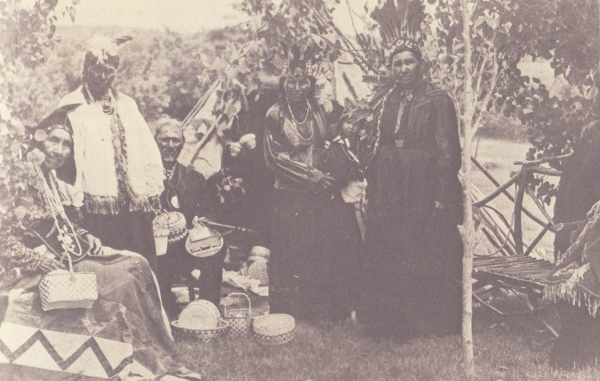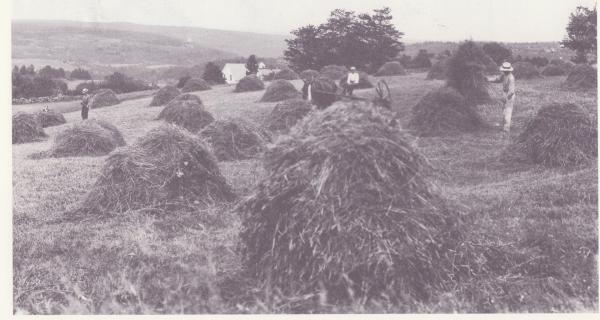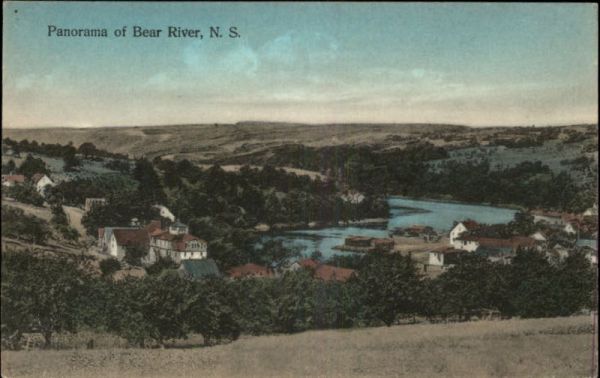Harry Hill 1913-2005
by Angela McMullen
Anyone privileged to have known Harry Hill of Bear River cannot help but smile when hearing his name. This charming sage was a member of the community for ninety-one years, leaving behind a loving legacy for future generations.
He was so highly respected, that following his death, a monument was erected in the village waterfront park in his honor. Many family members, friends, village residents and political figures gathered to honor the man who made such an imprint on our village.
The story of Harry Hill begins after the American Revolution, when the government granted his Black Loyalist family a parcel of land in nearby Greenland.One of sixteen children, Harry was born to Benjamin and Blanche Hill. Together, the Hill family worked their land and lived off of its abundance.
With a grade nine education, he left school to work at Cunningham’s Mill at the head of the tide. Harry held various employment positions throughout his life, each one attended to with pride, honesty and dedication.
In addition to working at the Mill, he was the janitor at Canada Post for thirteen years. He was also the caretaker of Mount Hope Cemetery, where he maintained the grounds and dug graves for thirty-nine years, a position which he held until age eighty.
Admired for his exceptional work ethic, Harry was an individual who had learned to balance work with pleasure. It can be said that Harry was the backbone of the community. His passions included singing in the choir at the Advent Church, and engaging the youth of the community to participate in various activities.
He was the coach of the girls’ softball team for over a decade, and operated the skating rink behind the Fire Hall for eighteen years. Many residents fondly remember Harry tying their skates as children, and even teaching them how to skate. He was so committed to this cause, that he often spent time at the rink late into the night making ice.
Harry is affectionately remembered for his extraordinary fashion sense. When asked to describe Harry Hill, a local resident respectfully said, “He looked like a peacock.” She was referring to the flamboyancy of his attire.
An enjoyable out-of-town excursion for Harry involved traveling to Halifax on the train, where he visited family and shopped for additions to his colorful wardrobe. Making his way up the aisle of the train, he introduced himself to the passengers with the tip of his fedora and a friendly handshake. “Harry Hill of Bear River.”
A merchant at a particular clothing outlet in Halifax was so impressed with this country gentleman that he extended him credit, allowing him the opportunity to pay for his purchases at his leisure.
Although Harry was a busy man, he took the time to acknowledge everyone, entertaining tourists with stories of his town and giving advice to the locals when asked.
People loved his sincerity and gregarious nature. Such an honor it was to be photographed with Harry Hill of Bear River! Love for his town and an interest in its people earned him the title of Ambassador of Bear River.
One of Harry’s favorite things was his bicycle, which he could be seen riding along the narrow streets in all kinds of weather, rain or shine. Another one of Harry’s favorites was a photograph of Oprah Winfrey, an autographed gift which he was so very proud of.
Harry was an avid pool player and even had his own seat at the local Legion.
Harry loved the ladies and he loved life. The monument by the riverside is a testament to his sense community spirit, his diligence in promoting kindness and love, and to his honesty and integrity.
*******************************************************
Visit the Cherries and Cherry Carnival page to see a film clip of Harry when he was 15.
*********************************************************
MORE ABOUT HARRY HILL
This is a story of Harry Hill’s life as told by Harry Hill himself. (2003)
“My name is Harry Hill and I was born May 14, 1913, which makes me 90 years young. I have lived in Bear River Nova Scotia all of my life and there were 16 in my family. I started school when I was 5years old at the old Oakdene school which burned down in 1934. Not having a fire department like today, buckets of water were used to put out the fire, which didn’t work and the Anglican Church next door burned down also. Thank the Lord that the wind wasn’t blowing the other way. Times were tough in those days, and I can remember working for 10 cents an hour. We ate well and were always kept clean as cleanliness was next to godliness even if you were not rich.
I only remember nice things about going to school and being the teacher’s pet. At 19 year of age I left school (grade 10) on permission of my father. School only went as far as grade 11. I went to work at the JH Cunningham stave mill were I worked for 26 years, working in all departments. There were a lot of people looking for jobs during the depression, and you had to prove yourself physically and mentally. A stave is a curved piece of wood forming parts of the sides of a wooden barrel. There was also a cooper who was responsible for the metal rings to make the barrels. The barrels in those days were used for holding nails and apples for instance, and wooden boxes were made for cherries and other things. This was before cardboard took over. Wooden barrels went to the Sydney Steel factory. This was a thriving community area with about 1800 people and other industries like a clothespin factory.
My father, Benjamin Hill, was a master stone mason, and I went to work with my father who had worked in Halifax after the terrible Halifax explosion and he had been a stonemason foreman also. You worked where the work was. I worked at the Cornwalllis Naval base and at the Digby Pines for example. Later on, I worked at building the present Bear River Post Office which is made of bricks and after th Post office was built, I got the job as cleaner, maintenance worker. I worked at this job for 13 and a half years. Oh, there was a time previously that I had worked for the Nova Scotia Power Company for a bit over a year.
In 1956, I got the position of caretaker of the Mount Hope Cemetery, Bear River. I worked at the Mount Hope Cemetery for 39 years which I did with great pride and honour. The cemetery was kept in good shape at all times and many a photograph was taken of me and the grounds by people from all over the world. It became a tourist attraction also.
I was brought up to respect God and look on life on this planet like four seasons and when the Lord wants you, you will have nothing to say about it or complain about it, In essense, you can talk or complain all you want about the wether and death, it is the only thing you can be sure of. I never discuss it too much but it was very difficult for me getting the gravesite ready for members of my own family, and most have moved on. Then, on the other hand, I buried people who were not very nice either and some of these I wished them a better life after. I believe in the words of the good book and don’t mind speaking and preaching to young people of todaa on values and to have respect for life.”
Harry Hill was called by his Lord on the 9th of April, 2005, age 91.
Here are some of Harry Hill’s memories of life in Bear River, which he talked about at a presentation at Oakdene Center in July 1997.
There were 11 stores in town including a jewellery store.
There were apple and cherry exports.
There was a stone cutting business, and a business that made memorials.
The Bear River Packett went back and forth to St. John.
There was a shipbuilding yard where the fire department is now.
Timber sold for $2.50 per hundred feet.
There were more than a 100 employees at Lake Jolly including the clothespin factory and the cooks.
Cunningham’s Mill burned in 1934. He worked ther 26 years.
In the 1930’s depression, nothing moved for nine months.
The Lincoln Pulp and Paper was where the Legion is now.
The rate of pay for labour was 10 cents per hour for ten hour days. During the war it was $7.00 per day.
**************************************************
************************************************
For a transcript of an interview with Harry Hill go to http://www.municipalities.com/elders/elder_harryhill.htm
We would love to add more memories of Harry Hill and any photos you would like to share. Email thebearrivertides@gmail.com to let us know.
all contents of this page are copyright of the Bear River Tides and Think for yourself publishing. 2012









































































You must be logged in to post a comment.